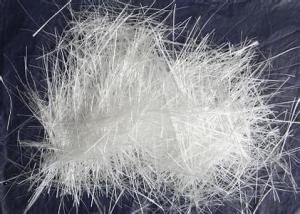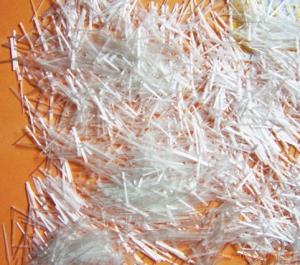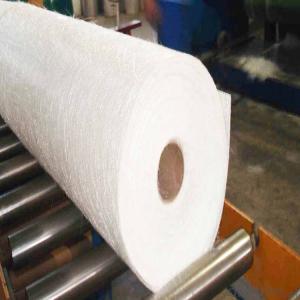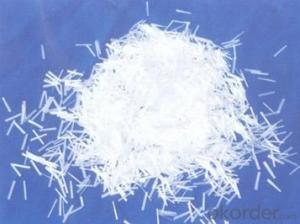Fiber Glass Chopped Strands For Thermoplastics
- Loading Port:
- China Main Port
- Payment Terms:
- TT or LC
- Min Order Qty:
- 20000 kg
- Supply Capability:
- 200000Kg Per Month kg/month
OKorder Service Pledge
OKorder Financial Service
You Might Also Like
1.Brief Introduction
Chopped Stands for Thermoplastic are based on silane coupling agent and special sizing formulation, compatible with PA,PBT/PET, PP, AS/ABS, PC, PPS/PPO,POM, LCP;
E-Glass Chopped Stands for thermoplastic are know for excellent strand integrity, superior flowability and processing property, delivering excellent mechanical property and high surface quality to its finished product.
2.Product Features
Extremely low resin demand, delivering low viscosity to BMC paste
High impact strength; High LOI rate
High strand stiffness; Compatible with rubber
3.Product Specifications
Property | Fibre diameter | Moisture Content | Size Content | Chop |
(%) | (%) | (%) | (%) | |
Mathods | IS01888 | ISO3344 | ISO1887 | |
3mm | ±10 | ≤3.0 | 0.1±0.05 | 98 |
6mm | ||||
9mm | ||||
12mm |
Special specification can be produce according to customer requirements.
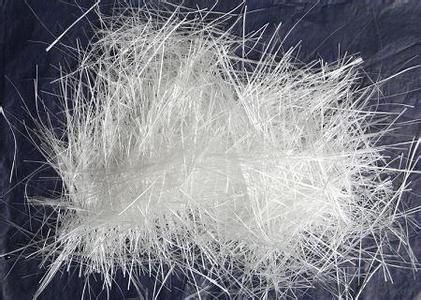
4.FAQ
Packaging:
Each bag can be taken (15-25kgs)。 Could also take a big container bag.
Storage:
Unless otherwise specified, It should be stored in a dry, cool and rain-proof area. It is recommended that the room temperature and humidity should be always maintained at 15℃~35℃ and 35%~65% respectively.
- Q:How does the moldability of the chopped strand affect its performance?
- The moldability of the chopped strand has a significant impact on its performance. The moldability refers to the ability of the chopped strand to conform and adapt to the shape of the mold during the manufacturing process. When the chopped strand has good moldability, it can be easily molded into complex shapes with intricate details. This allows it to be used in a wide range of applications where precise molding is required, such as automotive parts, aerospace components, and consumer goods. On the other hand, if the chopped strand has poor moldability, it can result in various performance issues. It may not fully conform to the mold, leading to gaps, voids, or uneven distribution of fibers. This can compromise the structural integrity and strength of the final product. Additionally, poor moldability can make it difficult to achieve consistent and uniform thickness, resulting in dimensional inaccuracies and variations in the finished product. Therefore, the moldability of the chopped strand is crucial in ensuring the overall performance and quality of the final product. By selecting a chopped strand with good moldability, manufacturers can achieve better structural integrity, dimensional accuracy, and overall performance in their molded products.
- Q:What are the water absorption properties of fiberglass chopped strand?
- Fiberglass chopped strand, commonly used in composite applications, possesses low water absorption levels due to the hydrophobic nature of its glass fibers. As a result, it is considered to have good resistance against water penetration. However, it is crucial to acknowledge that the degree of water absorption may differ based on variables like manufacturing process, fiberglass material quality, and the presence of surface coatings or treatments. In essence, fiberglass chopped strand is an appropriate option for applications necessitating water absorption resistance.
- Q:Two-way stretch plastic geogrid
- High-intensity Geonet, Geotextile, Uniaxial Plastic Geogrid, Steel-plastic composite Geogrid, Composite geomembrane, and two double to the grid line, Maree Modoo axial loom, Fiberglass geogrid, Polyester geogrid, Geonet, two one-way grille production line, Dornier loom.
- Q:How does the fiber content affect the thermal conductivity of chopped strand composites?
- The thermal conductivity of chopped strand composites is significantly affected by the fiber content. Generally, as the fiber content increases, the thermal conductivity of the composite decreases. This is because the fibers act as barriers to the flow of heat, thus insulating the material. The ability of a material to conduct heat determines its thermal conductivity. In chopped strand composites, the fibers are dispersed within a matrix material, which can be either a polymer or a resin. This dispersion of fibers creates a network of thermal resistances in the composite, which ultimately reduces its overall thermal conductivity. When the fiber content is low, the spacing between the fibers is larger, allowing for more pathways for heat transfer within the matrix material. Consequently, this leads to higher thermal conductivity. Conversely, as the fiber content increases, the spacing between the fibers decreases, resulting in a higher number of thermal resistances and ultimately reducing the thermal conductivity. Furthermore, the aspect ratio of the fibers also contributes to the thermal conductivity of chopped strand composites. Longer fibers with a higher aspect ratio offer more resistance to heat transfer, thereby further reducing the thermal conductivity. It is crucial to note that other factors, such as the properties of the matrix material, the alignment and orientation of the fibers, and the interfacial bonding between the fibers and the matrix, can also impact the thermal conductivity of chopped strand composites. Therefore, it is essential to have a comprehensive understanding of these factors in order to accurately predict and control the thermal conductivity of these materials.
- Q:Can fiberglass chopped strand be used in the production of aerospace structures?
- Aerospace structures can benefit from the utilization of fiberglass chopped strand. This versatile material possesses numerous advantages for aerospace applications, including a high strength-to-weight ratio, excellent thermal and electrical insulation properties, and resistance to corrosion and chemicals. When it comes to manufacturing composite materials for aerospace, fiberglass chopped strand can be employed. These composites, such as fiberglass-reinforced polymers (FRPs) or fiber-reinforced composites, offer enhanced strength and durability while remaining lightweight. This characteristic is particularly crucial in aerospace applications where reducing weight is essential. Fiberglass chopped strand finds utility in reinforcing various components within aerospace structures. These components include fuselage sections, wings, landing gear, interior panels, and engine parts. Techniques like filament winding, resin transfer molding, or hand lay-up can incorporate this material into the manufacturing process. Moreover, fiberglass chopped strand can be tailored to meet specific industry requirements. For instance, it can be customized to exhibit flame retardancy, low smoke emission, or high temperature resistance. This adaptability ensures that the material adheres to the stringent safety standards and performance criteria of the aerospace industry. In conclusion, the strength, lightweight properties, and resistance to environmental factors make fiberglass chopped strand an effective resource for the production of aerospace structures. Its integration into composite materials can significantly contribute to the overall performance and efficiency of aerospace components.
- Q:What are the manufacturing tolerances for fiberglass chopped strand?
- The manufacturing tolerances for fiberglass chopped strand may vary depending on the specific manufacturer and product. However, common tolerances for length and diameter are typically within a range of ±5%. Other factors such as moisture content and fiber distribution may also have their own tolerances. It is recommended to refer to the manufacturer's specifications or consult their technical documentation for precise information on the tolerances of a particular fiberglass chopped strand product.
- Q:Can fiberglass chopped strand be used in insulation applications?
- Indeed, insulation applications can make use of fiberglass chopped strand. Due to its exceptional thermal resistance properties, fiberglass chopped strand is frequently employed as a material for insulation. Its structure adeptly captures air pockets, effectively diminishing heat transfer and sustaining a consistent temperature within the insulated area. Moreover, the lightweight, durable, and moisture-resistant nature of fiberglass chopped strand insulation renders it appropriate for various insulation needs. Whether it is for residential structures, commercial establishments, or industrial facilities, fiberglass chopped strand insulation offers a reliable solution for thermal insulation demands.
- Q:Is fiberglass chopped strand compatible with different recycling processes?
- Yes, fiberglass chopped strand is compatible with different recycling processes. It can be processed through mechanical recycling methods where it is shredded and then melted to form new products. It can also be chemically recycled through processes such as pyrolysis or solvolysis, where it is broken down into its constituent components for reuse. Additionally, fiberglass chopped strand can be used as a reinforcement material in composite recycling, where it is incorporated into new composite materials. Overall, fiberglass chopped strand is versatile and can be effectively recycled through various processes.
- Q:Can fiberglass chopped strand be used in 3D printing?
- No, fiberglass chopped strand cannot be used in 3D printing. 3D printing typically requires materials in filament or powder form, whereas fiberglass chopped strand is a type of reinforcement material used in composite manufacturing processes.
- Q:Can fiberglass chopped strand be used in electrical insulation varnishes?
- Indeed, electrical insulation varnishes can make use of fiberglass chopped strand. This versatile material boasts remarkable electrical insulation characteristics. Its incorporation into varnishes amplifies the insulation and thermal resistance of the coating. By adopting the chopped strand form, fiberglass seamlessly integrates into the varnish composition, furnishing reinforcement and enhancing the mechanical strength of the insulation. Furthermore, fiberglass chopped strand aids in diminishing shrinkage and cracking of the varnish throughout the curing procedure, thereby advancing the insulation's overall performance and durability.
1. Manufacturer Overview |
|
|---|---|
| Location | |
| Year Established | |
| Annual Output Value | |
| Main Markets | |
| Company Certifications | |
2. Manufacturer Certificates |
|
|---|---|
| a) Certification Name | |
| Range | |
| Reference | |
| Validity Period | |
3. Manufacturer Capability |
|
|---|---|
| a)Trade Capacity | |
| Nearest Port | |
| Export Percentage | |
| No.of Employees in Trade Department | |
| Language Spoken: | |
| b)Factory Information | |
| Factory Size: | |
| No. of Production Lines | |
| Contract Manufacturing | |
| Product Price Range | |
Send your message to us
Fiber Glass Chopped Strands For Thermoplastics
- Loading Port:
- China Main Port
- Payment Terms:
- TT or LC
- Min Order Qty:
- 20000 kg
- Supply Capability:
- 200000Kg Per Month kg/month
OKorder Service Pledge
OKorder Financial Service
Similar products
New products
Hot products
Related keywords


